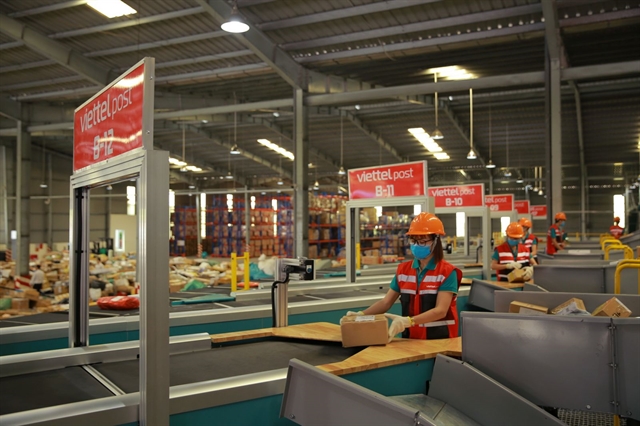 Economy
Economy

Strengthening digital transformation in the logistics industry was an important solution to enhance capacity and competitiveness of logistics companies as well as service quality in Việt Nam.

|
| A logistics centre of Viettel Post which applies technology in operation and supervision. Strengthening digital transformation in the logistics industry is an important solution to enhance capacity and competitiveness of logistics companies as well as service quality in Việt Nam. — Photo viettelpost.com.vn |
HÀ NỘI — Strengthening digital transformation in the logistics industry was an important solution to enhance capacity and competitiveness of logistics companies as well as service quality in Việt Nam.
This solution was highlighted in the recent adjusted action plan to improve the competitiveness and develop logistics services in Việt Nam by 2025.
Accordingly, the contribution of logistics services to the country’s gross domestic product (GDP) would be around 5-6 per cent in 2025, compared to the target of 8-19 per cent set in the action plant approved in 2017.
The logitics services in Việt Nam were expected to grow at around 15-20 per cent annually with the logistics services to be cut to 16-20 per cent of GDP.
The adjusted action plan also targeted that Việt Nam ranked at least 50th in the world by the logistics performance index.
Việt Nam’s logistics industry was currently expanding at around 12-14 per cent per year and contributed some 4-5 per cent to GDP.
The World Bank’s 2018 report ranked Việt Nam 39th out of 160 countries by LPI, a jump of 25 spots against 2016. Việt Nam came just behind Singapore and Thailand by logistics performance in ASEAN.
However, the logistics cost remained high, which was undermining the competitiveness of Việt Nam’s logistics industry.
A logistics report by the Ministry of Industry and Trade showed that logistics cost averaged around 17 per cent of the total revenue of enterprises in Việt Nam in 2020, a significant drop compared to the previous figure of 25 per cent, but still higher than many countries.
Statistics from the Việt Nam Logistics Business Association showed that logistics costs were equivalent to 17 per cent of GDP. A study by the US’ Armstrong & Associates showed that logistics costs were equivalent to 20.9 per cent of GDP, much higher than other countries in the region and more than the global average of 14 per cent.
According to the Việt Nam Chamber of Commerce and Industry, it was necessary to promote the application of technology and digital transformation in the logistics industry which would be the key for Vietnamese logistics companies to lower operation costs, improve competitiveness and create breakthroughs in the context of rapid international integration.
Under the Government’s adjusted action plan for logistics development, focus would be placed on research and development of new technology in managing and operating the logistics supply chains as well as logistics services.
Other important solutions were developing logistics trading platforms and improving the logistics infrastructure system in association with the development of e-commerce.
According to the Việt Nam Logistics Business Association, there were around 4,000 logitics companies in Việt Nam, more than 90 per cent of them were of small and medium size.— VNS
VN moves up in logistics ranking Việt Nam moved up three spots to rank 8th out of 50 countries in the global freight forwarder Agility’s ranking of Emerging Market Logistics Index 2021 which was published recently, displacing regional partner Thailand in the top 10. This demonstrated that Việt Nam effectively limited the spread of the virus, positioned itself deftly to absorb manufacturers seeking to leave China and possessed an enviable investment pipeline across a number of sectors, including fashion and electronics, which could see its rise continue in 2022, the report wrote. Việt Nam was among emerging markets countries looked to be emerging from the early pandemic downturn in positions of strength. “Việt Nam, meanwhile, has made strides as a manufacturing destination as a small number of companies have looked to ease dependence on Chinese production as a result of US-China trade friction, rising costs, and the pandemic. Việt Nam has seen an influx of foreign investment and has emerged as a popular manufacturing location. Việt Nam moved aggressively and effectively to prevent the spread of COVID-19.” However, the report pointed out that the investment and arrival of new businesses had created challenges. Investment in Việt Nam’s technology manufacturing sector was high, but there was a shortage of skills and knowledge to produce the highest value goods. A lack of local suppliers of components forces Việt Nam to import materials, predominantly from China, the report wrote. China ranked first in the Agiligy Emerging Market Logistics Index, followed by India, Indonesia, UAE, Malaysia, Saudi Arabia and Mexico. — VNS |




